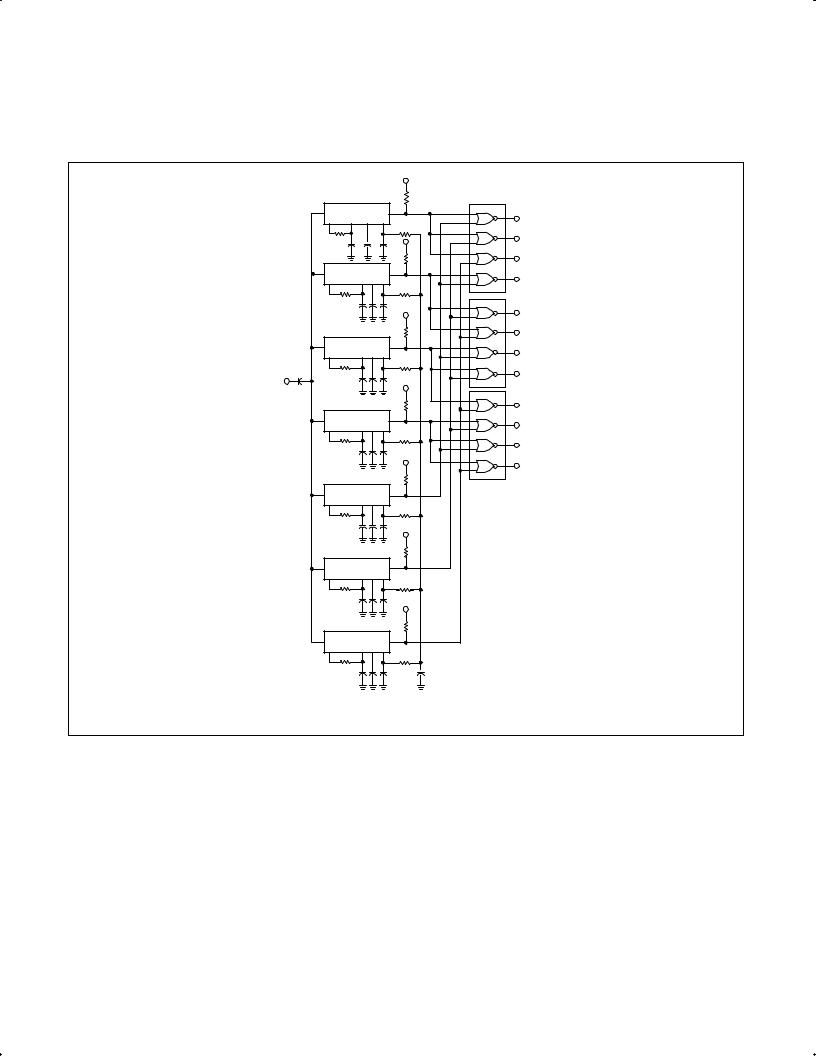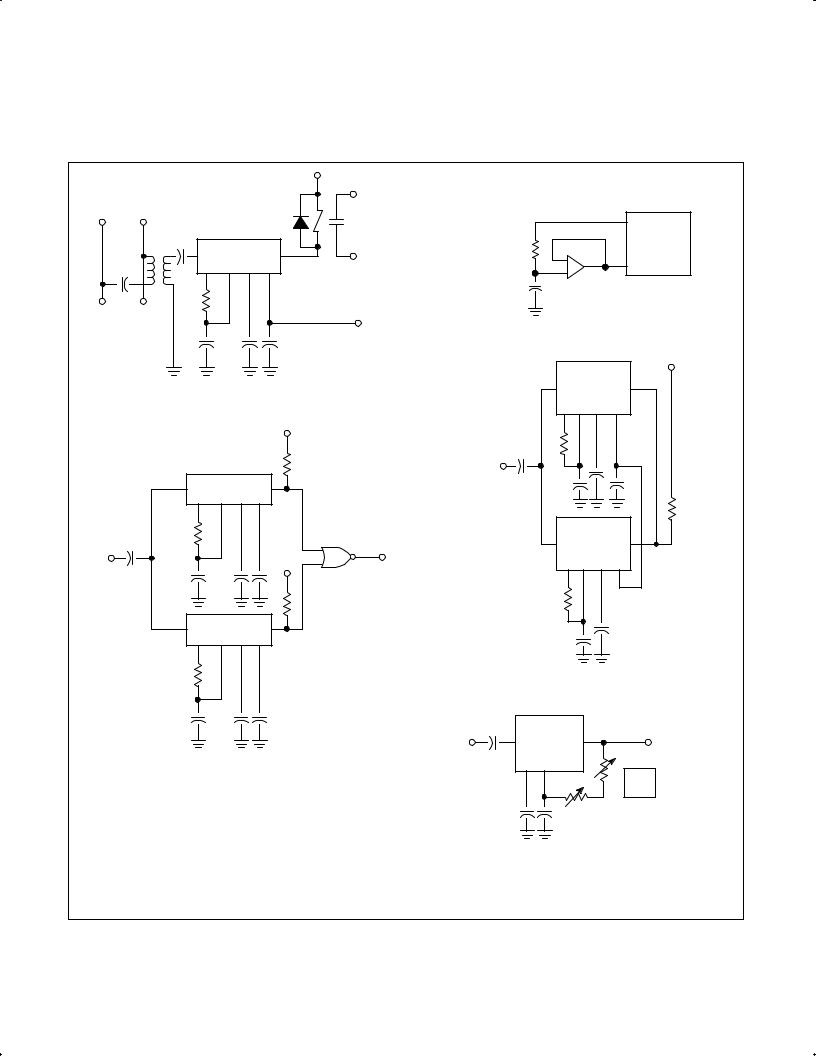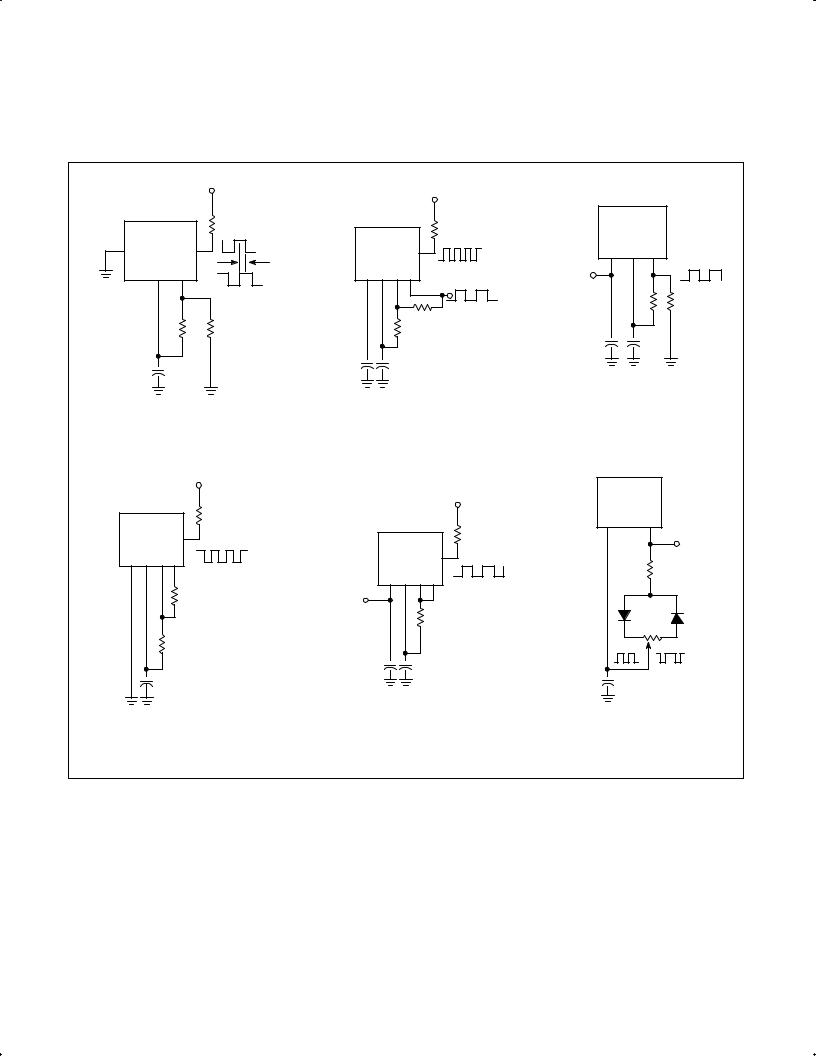
- •DESCRIPTION
- •FEATURES
- •APPLICATIONS
- •PIN CONFIGURATIONS
- •BLOCK DIAGRAM
- •ORDERING INFORMATION
- •ABSOLUTE MAXIMUM RATINGS
- •DC ELECTRICAL CHARACTERISTICS
- •TYPICAL PERFORMANCE CHARACTERISTICS
- •DESIGN FORMULAS
- •Detection Bandwidth (BW)
- •Lock Range
- •Detection Band Skew
- •OPERATING INSTRUCTIONS
- •TYPICAL RESPONSE
- •AVAILABLE OUTPUTS
- •OPERATING PRECAUTIONS
- •SPEED OF OPERATION
- •OPTIONAL CONTROLS
- •SENSITIVITY ADJUSTMENT
- •CHATTER PREVENTION
- •DETECTION BAND CENTERING (OR SKEW) ADJUSTMENT
- •ALTERNATE METHOD OF BANDWIDTH REDUCTION
- •OUTPUT LATCHING
- •REDUCTION OF C1 VALUE
- •PROGRAMMING
- •TYPICAL APPLICATIONS

Philips Semiconductors Linear Products |
Product specification |
|
|
|
|
Tone decoder/phase-locked loop |
NE/SE567 |
|
|
|
|
CHATTER PREVENTION (Figure 4)
Chatter occurs in the output stage when C3 is relatively small, so that the lock transient and the AC components at the quadrature phase detector (lock detector) output cause the output stage to move through its threshold more than once. Many loads, for example lamps and relays, will not respond to the chatter. However, logic may recognize the chatter as a series of outputs. By feeding the output stage output back to its input (Pin 1) the chatter can be eliminated. Three schemes for doing this are given in Figure 4. All operate by feeding the first output step (either on or off) back to the input, pushing the input past the threshold until the transient conditions are over. It is only necessary to assure that the feedback time constant is not so large as to prevent operation at the highest anticipated speed. Although chatter can always be eliminated by making C3 large, the feedback circuit will enable faster operation of the 567 by allowing C3 to be kept small. Note that if the feedback time constant is made quite large, a short burst at the input frequency can be stretched into a long output pulse. This may be useful to drive, for example, stepping relays.
ALTERNATE METHOD OF BANDWIDTH REDUCTION (Figure 6)
Although a large value of C2 will reduce the bandwidth, it also reduces the loop damping so as to slow the circuit response time. This may be undesirable. Bandwidth can be reduced by reducing the loop gain. This scheme will improve damping and permit faster operation under narrow-band conditions. Note that the reduced impedance level at terminal 2 will require that a larger value of C2 be used for a given filter cutoff
frequency. If more than three 567s are to be used, the network of RB and RC can be eliminated and the RA resistors connected together. A capacitor between this junction and ground may be required to shunt high frequency components.
OUTPUT LATCHING (Figure 7)
To latch the output on after a signal is received, it is necessary to provide a feedback resistor around the output stage (between Pins 8 and 1). Pin 1 is pulled up to unlatch the output stage.
DETECTION BAND CENTERING (OR SKEW) ADJUSTMENT (Figure 5)
When it is desired to alter the location of the detection band
(corresponding to the loop capture range) within the lock range, the circuits shown above can be used. By moving the detection band to one edge of the range, for example, input signal variations will expand the detection band in only one direction. This may prove useful when a strong but undesirable signal is expected on one side or the other of the center frequency. Since RB also alters the duty cycle slightly, this method may be used to obtain a precise duty cycle when the 567 is used as an oscillator.
REDUCTION OF C1 VALUE
For precision very low-frequency applications, where the value of C1 becomes large, an overall cost savings may be achieved by inserting a voltage-follower between the R1 C1 junction and Pin 6, so as to allow a higher value of R1 and a lower value of C1 for a given frequency.
PROGRAMMING
To change the center frequency, the value of R1 can be changed with a mechanical or solid state switch, or additional C1 capacitors may be added by grounding them through saturating NPN transistors.
April 15, 1992 |
412 |

Philips Semiconductors Linear Products |
Product specification |
|
|
|
|
Tone decoder/phase-locked loop |
NE/SE567 |
|
|
|
|
TYPICAL APPLICATIONS
NOTES:
Component values (Typical) R1 = 26.8 to 15kΩ
R2 = 24.7kΩ
R3 = 20kΩ C1 = 0.10mF
C2 = 1.0mF 5V
C3 = 2.2mF 6V
C4 = 250μF 6V
|
|
+ |
|
|
|
R3 |
|
|
567 |
|
DIGIT |
|
897Hz |
R2 |
1 |
|
|
|
|
R1 |
C3 |
+ |
2 |
C1 |
C2 |
3 |
|
|
|
|
|
|
567 |
|
|
|
770Hz |
|
4 |
|
|
+ |
5 |
|
|
|
6 |
|
567 |
|
|
|
852Hz |
|
7 |
|
|
|
|
|
|
|
8 |
|
|
+ |
|
|
|
|
9 |
|
567 |
|
|
|
941Hz |
|
0 |
|
|
+ |
* |
|
|
|
|
|
567 |
|
|
|
1209Hz |
|
|
|
|
+ |
|
|
567 |
|
|
|
1336Hz |
|
|
|
|
+ |
|
|
567 |
|
|
|
1477Hz |
|
|
Touch-Tone Decoder
April 15, 1992 |
413 |

Philips Semiconductors Linear Products |
Product specification |
|
|
|
|
Tone decoder/phase-locked loop |
NE/SE567 |
|
|
|
|
TYPICAL APPLICATIONS (Continued)
+5 TO 15V
60Hz AC LINE |
50±200VRMS |
|
LOAD
|
C4 |
|
|
|
|
|
|
|
|
27pF |
|
|
|
|
|
|
|
|
|
3 |
|
567 |
|
8 |
|
K1 |
500pF |
|
5 |
|
6 |
2 |
1 |
|
|
1:1 |
|
R1 |
|
|
|
|
|
|
|
|
2.5kΩ |
|
|
|
|
|
|
fO ≈ 100kHz |
|
|
|
|
|
C2 |
|
|
|
|
|
|
|
|
|
|
|
|
|
|
C1 |
.006 |
C3 |
AUDIO OUT |
||
|
|
|
|
|
||||
|
|
|
|
|
|
|
(IF INPUT IS |
|
|
|
0.004mfd |
|
|
.02 |
FREQUENCY |
||
|
|
|
|
|
|
|
|
MODULATED) |
Carrier-Current Remote Control or Intercom |
||||||||
|
|
|
|
|
|
|
+V |
|
|
|
|
|
|
|
|
20k |
|
|
f1 |
3 |
|
567 |
|
8 |
|
|
|
|
|
|
|
|
|||
|
|
5 |
6 |
2 |
|
1 |
|
|
|
|
R1 |
|
|
|
|
|
|
INPUT |
|
|
|
|
|
|
+V |
NOR |
CHANNEL |
|
C1 |
|
C2 |
|
C3 |
|
|
OR RECEIVER |
|
|
|
|
|
|||
|
|
|
|
|
|
|
|
|
|
|
|
|
|
|
20k |
|
|
|
f2 |
3 |
|
567 |
|
8 |
|
|
|
|
|
|
|
|
|||
|
|
5 |
6 |
2 |
|
1 |
|
|
|
|
R'1 |
|
|
|
|
|
|
|
|
C'1 |
|
C'2 |
|
C'3 |
|
|
Dual-Tone Decoder
|
|
|
5 |
R1 |
|
|
567 |
± |
|
|
|
|
+ |
6 |
|
|
|
||
|
+ |
|
|
|
|
|
|
C1 |
|
|
5741 |
Precision VLF
INPUT SIGNAL (>100mVrms)
VO
|
|
|
|
+V |
|
|
|
3 |
|
567 |
8 |
|
|
|
|
5 |
6 |
2 |
1 |
|
|
|
|
R1 |
|
|
|
|
|
|
|
|
|
C2 |
|
|
|
|
|
C1 |
|
|
C3 |
|
|
|
|
|
|
|
|
|
|
|
RL |
3 |
|
567 |
8 |
|
|
|
|
5 |
6 |
2 |
1 |
|
|
|
|
R'1 |
|
|
C C |
|
|
|
130 |
|
|
|
|
(mfd) |
|||
|
|
|
2 |
2 |
|
|
fO |
|
|
|
C C |
1 |
|
|
|
|
|
|
1 |
|
|
|
|
|
|
|
R 1.12R |
1 |
|||
C'1 |
|
|
1 |
|
|
||
|
|
C'2 |
|
|
|
|
|
24% Bandwidth Tone Decoder
|
|
|
|
OUTPUT |
|
|
|
|
(INTO 1k |
|
|
|
|
OHM MIN. |
100mv (pp) |
|
|
|
LOAD) |
|
|
|
|
|
SQUARE OR |
3 |
567 |
5 |
|
50mVRMS |
|
|
||
|
|
|
|
|
SINE INPUT |
|
|
|
f2 |
|
2 |
6 |
|
|
|
|
|
R1 |
+90° |
|
|
|
PHASE |
|
|
|
|
|
SHIFT |
C2 C1
NOTES:
R2 = R1/5
Adjust R1 so that φ = 90° with control midway.
0° to 180° Phase Shifter
NOTES:
1.Resistor and capacitor values chosen for desired frequencies and bandwidth.
2.If C3 is made large so as to delay turn-on of the top 567, decoding of sequential (f1 f2) tones is possible.
April 15, 1992 |
414 |

Philips Semiconductors Linear Products |
Product specification |
|
|
|
|
Tone decoder/phase-locked loop |
NE/SE567 |
|
|
|
|
TYPICAL APPLICATIONS (Continued)
+
|
|
|
|
|
|
|
+ |
|
|
|
|
|
|
|
RL |
|
|
|
RL |
|
|
567 |
|
|
|
|
|
|
|
|
|
|
|
||
3 |
567 |
8 |
|
|
567 |
|
8 |
|
2 |
6 |
5 |
|
|
|
|
80° |
|
|
|
|
|
|
|
2 |
6 |
5 |
|
2 |
6 |
5 |
3 |
|
VCO |
|
|
CONNECT PIN 3 |
|
|
|
|
|
|
|
|
TERMINAL |
|
|
|
|
|
|
|
|
|
fO |
(±6%) |
|
|
|
TO 2.8V TO |
|
|
|
|
|
|
|
|
R1 |
RL > 1000Ω |
|
INVERT OUTPUT |
|
|
|
|
|
|
|
|
|
||
|
|
R1 |
RL > 1000Ω |
|
|
|
R1 |
|
|
|
|
|
|
|
|
|
|
|
10k |
|
|
C1 |
|
|
|
|
|
|
|
|
|
|
C2 |
||
|
|
CL |
|
C2 |
|
C1 |
|
|
|
|
|
Oscillator With Quadrature Output |
Oscillator With Double Frequency |
Precision Oscillator With 20ns |
|
Output |
Switching |
||
|
|
|
|
+ |
|
|
|
|
|
|
|
|
|
|
+ |
567 |
|
|
|
|
|
|
|
|
|
|
|
RL |
|
|
6 |
5 |
|
|
|
|
|
|
||
|
567 |
|
8 |
|
|
RL |
OUTPUT |
3 |
6 |
5 |
1 |
567 |
8 |
|
|
|
|
|
|||||
|
|
|
1kΩ (MIN) |
||||
|
|
|
|
|
|
|
|
|
|
|
2 |
6 |
5 |
1 |
|
|
|
|
10kΩ |
|
|
|
|
|
|
|
VCO |
|
|
|
|
|
|
|
TERMINAL |
|
|
R1 |
|
|
|
|
(±6%) |
|
|
100kΩ |
|
|
|
|
|
|
|
|
|
|
|
|
R1 |
|
|
|
|
|
|
|
C2 |
|
C1 |
|
DUTY |
|
|
C1 |
|
|
|
C1 |
|
|
|
|
|
|
CYCLE |
||
|
|
|
|
|
|
|
ADJUST |
Pulse Generator With 25% Duty Cycle |
Precision Oscillator to Switch 100mA |
Pulse Generator |
|
Loads |
|||
|
|
April 15, 1992 |
415 |
